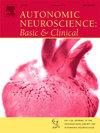Sex-related differences in temperature regulation during heat stress from childhood to older age
IF 3.3
4区 医学
Q2 NEUROSCIENCES
引用次数: 0
Abstract
Epidemiological studies have observed that female sex is associated with a greater risk of adverse health outcomes during heat extremes. It remains unclear if sex-related differences in autonomic temperature regulation contribute to these observations. This narrative review article provides an overview of studies that compared autonomic temperature regulation during heat stress between males and females across the lifespan. Our literature search focused on studies that investigated components of heat loss thermoeffector loops and/or that accounted for confounding differences in body morphology and metabolic heat production between males and females. Guided by this framework, we present studies that compared autonomic temperature regulation between males and females during childhood to adolescence, adulthood, middle-age, and older age. The review highlights that few studies have specifically studied sex-related differences in autonomic temperature regulation during heat stress. Most studies have focused on thermoeffector output and core temperature. In contrast, little is known regarding thermoafferent signalling, central integration of thermoafferent feedback, thermoefferent signalling and thermoeffector organ structure and function. Additional research is needed to understand how biological sex modulates autonomic temperature regulation during heat stress and how any sex-related difference may contribute to the greater health risks observed in females during heat extremes.
儿童期至老年期热应激期间温度调节的性别差异
流行病学研究发现,在极端高温期间,女性与更大的不良健康后果风险相关。目前尚不清楚自主温度调节中与性别相关的差异是否有助于这些观察结果。这篇叙述性的综述文章提供了研究的概述,比较了热应激过程中雄性和雌性在整个生命周期中的自主温度调节。我们的文献检索集中在研究热损失热效应回路的组成部分和/或解释男性和女性在身体形态和代谢产热方面的混淆差异的研究。在这个框架的指导下,我们提出了一些研究,比较了男性和女性在儿童期到青春期、成年期、中年期和老年期的自主体温调节。这篇综述强调,很少有研究专门研究热应激过程中自主温度调节的性别相关差异。大多数研究都集中在热效应输出和核心温度上。相比之下,对热传入信号、热传入反馈的中心集成、热传入信号和热效应器官的结构和功能知之甚少。需要进一步的研究来了解生物性别如何调节热应激期间的自主温度调节,以及任何与性别相关的差异如何可能导致在极端高温期间观察到的女性更大的健康风险。
本文章由计算机程序翻译,如有差异,请以英文原文为准。
求助全文
约1分钟内获得全文
求助全文
来源期刊
CiteScore
5.80
自引率
7.40%
发文量
83
审稿时长
66 days
期刊介绍:
This is an international journal with broad coverage of all aspects of the autonomic nervous system in man and animals. The main areas of interest include the innervation of blood vessels and viscera, autonomic ganglia, efferent and afferent autonomic pathways, and autonomic nuclei and pathways in the central nervous system.
The Editors will consider papers that deal with any aspect of the autonomic nervous system, including structure, physiology, pharmacology, biochemistry, development, evolution, ageing, behavioural aspects, integrative role and influence on emotional and physical states of the body. Interdisciplinary studies will be encouraged. Studies dealing with human pathology will be also welcome.

 求助内容:
求助内容: 应助结果提醒方式:
应助结果提醒方式:


